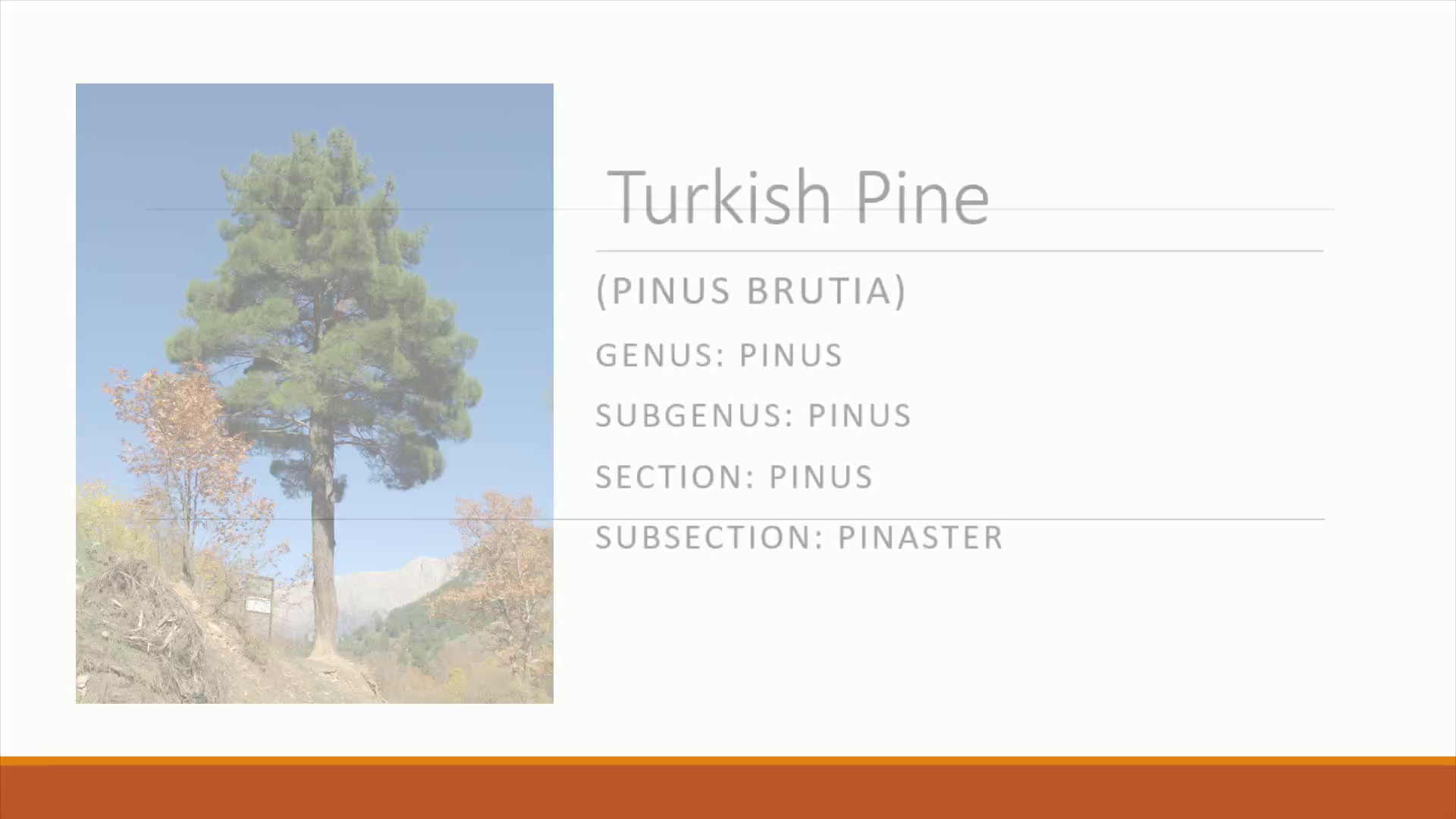Page 1 (0s)
[Audio] The Turkish Pine Pinus brutia. Turkish Pine.
Page 2 (12s)
[Audio] The Turkish Pine, otherwise known as the Calabrian Pine, is medium-size evergreen coniferous tree, reaching 20 to 35 meters or ( 66 to 115 feet) tall with a trunk diameter of up to 1 meter or ( 3 feet), exceptionally 2 meters or (6 feet). The bark is orange-red, thick and deeply fissured at the base of the trunk, and thin and flaky in the upper crown. The needle-like leaves are in pairs, slender, mostly 10 to 16 centimeters or ( 4 to 6 inches) long, bright green to slightly yellowish green. The cones are stout, heavy and hard, 6 to 11 centimeters or ( 2 to 4 inches) long and 4 to 5 centimeters or (1 to 2 inches) broad at the base when closed, green at first, ripening glossy red-brown when 24 months old. The bulk of its range is in Turkey, but it also extends to southeasternmost Bulgaria, the East Aegean Islands of Aegean Sea, Crete, Crimea, Iran, Georgia, Azerbaijan, northern Iraq, western Syria, Lebanon and Cyprus. It generally occurs at low altitudes, mostly from sea level to 600 meters or ( 2,000 feet), up to 1,200 meters or ( 3,900 feet) in the south of its range. It is closely related to Aleppo pine, but can be easily distinguished by looking at the foliage. It is widely planted for timber, both in its native area (it is the most important tree in forestry in Turkey and Cyprus) and elsewhere in the Mediterranean region east to Pakistan. The timber is used for many purposes including carpentry, industry, general constructions, firewood and pulp. Pinus brutia subspecies Eldarica, commonly known as Afghan Pine, is often planted in the southwestern United States, due to its excellent drought and heat tolerance..
Page 3 (2m 10s)
[Audio] Subspecies Pinus brutia has 4 known subspecies: Pinus brutia subspecies Brutia It has the typical form; Most of the range is in Anatolia. Pinus brutia subspecies eldarica. Range is in Azerbaijan, needles 3- 5 inches long; adapted to a drier climate with a summer rainfall peak, and is commonly planted in the southwestern United states. Pinus brutia subspecies Pendufolia. It Inhabits the southern coastal regions of Turkey; The needles are longer than other subspecies, at 7 to 11 inches long. Pinus brutia subspecies Pityusa. Its Range is in Georgia and the Russian black sea coast, and is very similar morphologically to subspecies Brutia..
Page 4 (3m 3s)
[Audio] How to grow Turkish Pine Collect the turkish pine tree cones in May, when the cones mature. Separate seeds from the cone and soak them in water for 24 hours. Turkish pine seeds are relatively easy to germinate and grow. The dormancy within the seed is short and easily broken. In fact the seeds can be sown without pre-treatment and achieve good results. Sow the soaked seed in pots or cell trays, then cover with a light layer of soil. Germination will begin a week to 10 days from sowing. The seedlings are reasonably robust and trouble free and usually grow to a height of between 5 and 10 centimeters in the first growing season depending on the sowing date. Densely sown seedlings are at risk from fungal diseases such as "damping off" which can cause rapid loss of many seedlings. Developing seedlings should be fine in full sun, keep them well watered and free of competing weeds. Growth in the first year is modest , usually between 5 and 10 centimeters and will accelerate in the second year. 2 year old seedlings normally reach a height of between 15 and 40 centimeters..
Page 5 (4m 21s)
[Audio] Where to grow Turkish Pine This species is drought resistant, and thrives in hot dry climates and poor soils. The Afghan pine and its subspecies grow best in USDA zones 6 to 10, and Sunset garden zones 6 to 9, 12 to 24. thank you for watching this video, and i hope you found it informative. have a great day!.
